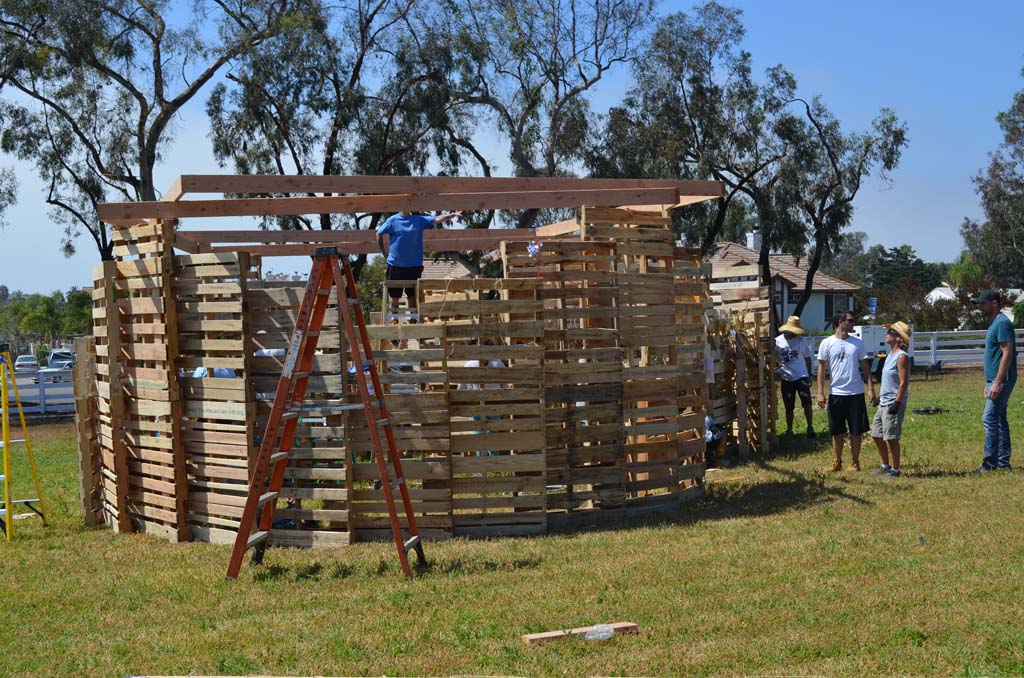New Leichtag fellowship program playing a role in Sukkah structures
ENCINITAS — In more ways than one, the Leichtag Foundation aims to put a modern spin on old agricultural traditions at the property where the Eckes once grew poinsettias.
Take the recent Sukkah Design Expo, which kicked off on Sunday. Design teams, volunteers and fellows built three Sukkahs — ephemeral dwellings in which Jews gather to celebrate the agricultural festival of Sukkot — on a field near the entrance of what’s tentatively being called the Ranch.
“We’re trying to reboot some of these ancient ideas, and refract them through a modern, contemporary lens,” said Rabbi Andy Kastner, director of the fellowship program.
For the Jewish community, Sukkahs have long represented harvests. They also serve as a reminder of when Israelites are said to have taken refuge in them while wandering through the desert in biblical times.
The historical significance dovetails with the nonprofit Leichtag Foundation’s plans for the 67-acre Ranch. It purchased the property on 441 Saxony Rd. last year, in part, to honor and restore agricultural heritage through events like the expo, according to representatives from the foundation.
Sukkahs are usually built at places of worship or at private homes. But in recent years, communal Sukkah construction has become more popular in places like New York City, allowing architects to showcase their skills with state-of-the-art ideas and technology. Kastner said that it inspired the Leichtag Foundation to hold its own expo, and it’s believed that Sunday’s event was the largest display of Sukkahs in the county yet.

Three Sukkahs were built, one representing light, another water and another earth. While the designers took advantage of modern materials and architecture techniques, they still had to conform to Jewish tradition.
For instance, the earth Sukkah has three walls, its rock base can withstand strong winds and its leafed roof offers shade by day and a view of the stars at night. And despite all the hard work that went into assembling the Sukkah, it will be taken down next week, explained Daron Joffe, an organic farmer and one of the lead designers.
“The whole point is that they go up and then they come down,” said Joffe, who also goes by “Farmer D.” “That makes it more special and unique each year.”
What’s contemporary about the earth Sukkah?
A water circulation system supports lettuce growing on the walls from Go Green Agriculture, a hydroponic farm that recently set up in a greenhouse on the Leichtag-owned site.
The walls symbolize the innovation bubbling up on the property, Joffe said.
Alongside Go Green Agriculture, Leichtag envisions hosting other innovating farming businesses on The Ranch down the line.
Plus, there are loose plans to grow a 3-acre urban farm on a plot to the north of the entrance. Leichtag is also eyeing planting a “food forest” — a farming technique with origins in prehistoric times, but that has seen a resurgence recently in cities like Seattle.
Food forests re-create the ecosystem of a real forest with an array of trees, vegetables, fruits and nuts.
Though only conceptual at this point and without a timeline, it would run along a trail on the northern edge of the site and a separate Shea Homes development. As per Jewish tradition, part of the forest would be dedicated to providing access to produce for those in need.
But sticking to what’s currently tangible — elsewhere on Sunday, designers incorporated other creative, modern approaches into their Sukkahs.
The walls of the water Sukkah are made up of recycled pallets; unique crystals will reflect moonlight in the light Sukkah.
Over the next several days, 10 nonprofits will take turns eating dinner in the Sukkahs. And at the end of Sukkot this weekend, a panel will vote on its favorite Sukkah.
Among those lending a hand to the Sukkah designs: eight farmers who are a part of a 15-month fellowship program, which began last week. Twenty-three-year-old Yasha Magarik, one of the fellows, said the program is a chance to marry his values with cutting edge farming.
“I’ve been interested lately in how to synthesize my Jewish identity with the values in sustainable agriculture,” said Magarik, who hails from Brooklyn, N.Y., and has more than three years of farming experience.
His passion for agriculture-related endeavors took hold when he first began farming and learned more about the food system.
“You start thinking through the ethical and environmental implications of what you’re eating,” Magarik said.
During the 15 months, the fellows will split their time between consulting for food-related nonprofits and working on various projects throughout Leichtag-owned property.
For Magarik, that means bringing more fresh produce into hospitals and schools as part of the Childhood Anti-Obesity Initiative. As for the foundation, the fellows will guide potential projects like the food forest.
Of the fellows, six are from across the nation and two come from Israel. Kastner, who’s leading the fellows, said they each bring different farming expertise to the table.
“We have a dream team with us,” Kastner said.
For the next 15 months, they’ll live in restored buildings that once housed farmhands who grew poinsettias for Ecke Ranch. To Kastner, it’s another example of something old becoming new again on the Ranch.


1 comment
Exited and wanting to join the great work Rabbi Andy Kastner of the Leightag foundation is doing on organic farming, here in enchanting Encinitas.
Comments are closed.